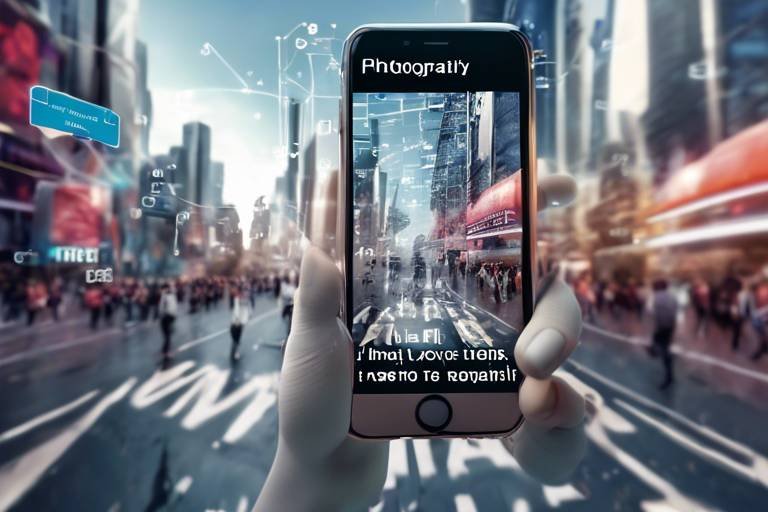The Future of Augmented Reality Powered by AI
Augmented Reality (AR) is no longer a concept confined to sci-fi movies; it's rapidly becoming a part of our everyday lives, and when you throw Artificial Intelligence (AI) into the mix, the possibilities become even more thrilling! Imagine walking down the street, and your smartphone not only shows you the nearest coffee shop but also predicts your favorite drink based on your past orders. This is just a glimpse of what the future holds as AR and AI converge to create experiences that are not only interactive but also incredibly personalized. As we delve deeper into this fascinating world, we will explore how these technologies are reshaping industries, enhancing user engagement, and what challenges lie ahead.
In recent years, we've witnessed significant advancements in AR technology that are reshaping user experiences in ways we never thought possible. From improved hardware capabilities to sophisticated software algorithms, these innovations are making interactions more immersive and intuitive. For instance, AR glasses are becoming lighter and more comfortable, allowing users to engage with digital content seamlessly. Imagine wearing a pair of glasses that overlay information directly onto your field of vision, enhancing your understanding of the world around you. This is not just a dream; it’s becoming a reality in sectors like education, retail, and tourism, where users can learn or shop in a more engaging manner.
AI algorithms are the secret sauce that significantly enhance AR applications. By enabling real-time data processing and personalized experiences, AI takes AR from being merely a visual overlay to an interactive experience tailored just for you. For example, think about how a museum could use AR to provide personalized tours. With AI analyzing your interests and preferences, it could curate a unique experience that highlights exhibits you’re most likely to enjoy. This level of customization not only keeps users engaged but also fosters a deeper connection with the content.
Machine learning models play a crucial role in analyzing user behavior and preferences, making AR applications smarter and more adaptive. By studying how users interact with AR content, these models can identify patterns and predict future behavior. This means that the more you use an AR app, the better it gets at serving your needs. For instance, if you frequently use AR for fitness training, the app could suggest personalized workouts based on your past performance, helping you achieve your goals more efficiently.
Personalization in AR applications is made possible through AI-driven insights. Imagine walking into a retail store where AR not only shows you the latest trends but also suggests outfits based on your style preferences and past purchases. This tailored experience can significantly increase user satisfaction and engagement, making shopping not just a chore but a delightful experience. The emotional connection users develop with personalized content can lead to higher brand loyalty and repeat visits.
Predictive analytics takes personalization a step further by anticipating user needs and preferences in AR environments. By leveraging data from various sources, AI can forecast what a user might want before they even realize it themselves. For example, in a gaming environment, AI could analyze your gameplay style and suggest new challenges that align with your skills, keeping the experience fresh and engaging. This proactive approach not only enhances user experience but also creates a more dynamic interaction with the content.
AR and AI are not just theoretical concepts; they are being employed in various industries with remarkable success. From healthcare, where AR assists surgeons during operations by overlaying critical information, to gaming, where immersive experiences are created that feel incredibly real, the applications are vast. Companies like IKEA have developed AR apps that allow customers to visualize furniture in their homes before making a purchase, drastically reducing the chances of buyer's remorse. These implementations showcase the benefits of combining AR and AI, leading to enhanced efficiency, better customer satisfaction, and innovative solutions to age-old problems.
Despite its immense potential, integrating AR with AI presents several challenges that need to be addressed. Technical limitations, ethical considerations, and user acceptance issues are just a few hurdles on the path to successful implementation. For instance, current hardware might not support the high processing power required for advanced AR applications, leading to laggy experiences that frustrate users. Additionally, the ethical implications surrounding privacy and data security cannot be overlooked, as users become increasingly aware of how their data is being utilized.
The current state of hardware and software can hinder the full potential of AR and AI integration. For example, many AR devices still struggle with battery life and processing power, which can limit the complexity of applications. However, advancements in chip technology and cloud computing are paving the way for solutions that could overcome these limitations, creating a more robust foundation for future innovations.
The use of AI in AR applications raises ethical concerns regarding privacy and data security. As these technologies become more intertwined, it is crucial to address issues surrounding user consent and data protection. Building user trust is essential for widespread adoption, and companies must prioritize transparency in how they collect and utilize data. By implementing strong ethical guidelines, the industry can ensure a safer and more secure environment for users.
Looking ahead, the convergence of AR and AI promises to revolutionize how we interact with digital content. Future trends may include even more sophisticated personalization, where AR experiences adapt in real-time to the user's emotional state or context. Imagine walking into a room, and the AR environment immediately adjusts to create a calming atmosphere based on your mood. As these technologies continue to evolve, they will undoubtedly lead to innovations that enhance our daily lives in ways we can only begin to imagine.
- What is Augmented Reality (AR)? AR is a technology that overlays digital information onto the real world, enhancing the user's perception of their environment.
- How does AI enhance AR experiences? AI improves AR by providing real-time data processing, personalization, and predictive analytics, making interactions more engaging and relevant.
- What industries are benefiting from AR and AI integration? Industries such as healthcare, retail, gaming, and education are leveraging AR and AI to create innovative solutions and improve user experiences.
- What are the main challenges in integrating AR and AI? Key challenges include technical limitations, ethical concerns regarding privacy, and ensuring user acceptance of these technologies.

Advancements in AR Technology
Recent innovations in augmented reality (AR) technology have been nothing short of revolutionary, reshaping user experiences and making interactions more immersive and intuitive than ever before. Imagine walking through a city and having digital information overlaid on your surroundings, guiding you to your next destination or even providing historical context about the buildings around you. This is not just a dream; it’s becoming a reality thanks to advancements in AR technology.
One of the most significant breakthroughs has been in the development of AR glasses and headsets that offer seamless integration of digital content with the real world. Devices like Microsoft’s HoloLens and Magic Leap have set the stage for a new era where users can engage with both physical and digital environments simultaneously. These devices utilize advanced sensors and cameras to map the surrounding environment, allowing for interactive experiences that were previously unimaginable.
Moreover, the rise of 5G technology is a game-changer for AR. With faster data speeds and lower latency, AR applications can now deliver high-quality content in real-time. This means that users can enjoy smoother and more responsive experiences, whether they are gaming, shopping, or exploring educational content. For instance, imagine a virtual fitting room where you can try on clothes virtually without ever stepping into a store. With 5G, this technology can operate seamlessly, making shopping more convenient and enjoyable.
Another exciting advancement is the integration of computer vision and machine learning into AR applications. These technologies enable devices to recognize and interpret the physical world, allowing for more complex interactions. For example, AR applications can identify objects in real-time, providing users with contextual information that enhances their understanding and engagement. Think of a museum app that can recognize an artwork and provide detailed information about the artist and the history behind it, all in real-time as you stand in front of the piece.
Furthermore, the development of cross-platform AR tools has made it easier for developers to create applications that work across various devices. Platforms such as ARKit and ARCore provide developers with the necessary tools to build AR experiences that can be accessed on smartphones and tablets. This democratization of AR technology means that more people can create and share their AR content, leading to a richer and more diverse ecosystem of applications.
In addition to these technological advancements, the growing interest in AR from industries like healthcare, education, and real estate is driving innovation. For example, in healthcare, AR is being used for surgical training, allowing medical professionals to practice procedures in a risk-free environment. In education, AR can bring subjects to life, making learning more engaging and interactive for students. Similarly, in real estate, virtual tours powered by AR technology are changing how potential buyers explore properties, allowing them to visualize spaces without physical visits.
As we look to the future, it’s evident that the advancements in AR technology are not just enhancing our interactions with the digital world but are also paving the way for entirely new experiences that blend seamlessly with our reality. The potential applications are vast, and as technology continues to evolve, we can expect even more innovative solutions that will change the way we perceive and interact with our environment.
- What is augmented reality? Augmented reality (AR) is a technology that overlays digital information, such as images and sounds, onto the real world, enhancing the user's perception of their environment.
- How is AI used in augmented reality? AI is used in AR to enhance user experiences by enabling real-time data processing, personalization, and predictive analytics, making interactions more intuitive and engaging.
- What are some applications of AR technology? AR technology is used in various fields, including healthcare for surgical training, education for interactive learning, and real estate for virtual property tours.
- What challenges does AR face? AR faces challenges such as technical limitations, ethical considerations regarding privacy, and the need for user acceptance and trust.

AI's Role in Enhancing AR
Augmented Reality (AR) is not just a flashy gimmick; it's a powerful tool that, when combined with artificial intelligence (AI), truly transforms the way we interact with our surroundings. Imagine walking down the street and seeing information about the buildings around you, or playing a game where the characters respond to your every move in real-time. This is the magic of AR, and AI is the wizard behind the curtain, making it all happen.
AI algorithms are crucial for enhancing AR applications, as they enable real-time data processing and create personalized experiences that adapt to the user's behavior and preferences. For instance, when you use an AR app to visualize furniture in your home, AI analyzes your past choices and suggests items that match your style. This level of personalization not only improves user satisfaction but also increases engagement, making users feel more connected to the technology.
At the heart of this enhancement lies machine learning, a subset of AI that allows systems to learn from data and improve over time. When integrated into AR applications, machine learning models analyze user behavior, preferences, and interactions to create smarter, more adaptive experiences. For example, if a user frequently interacts with specific types of content, the application can adjust its offerings accordingly. This dynamic adjustment makes the AR experience not just interactive but also intuitive, almost like having a personal assistant who knows your tastes and preferences.
Personalization in AR is achieved through AI-driven insights that allow applications to tailor content specifically for each user. This could range from customizing a virtual shopping experience to creating unique gaming scenarios based on a player's history. The result? Users are more likely to engage deeply with the content, as it feels relevant to them. Imagine a shopping app that not only shows you products you might like but also places them in your living room so you can see how they fit into your space. This is the future of shopping, and it’s powered by AI.
Another exciting aspect of AI's role in AR is the use of predictive analytics. By analyzing large sets of data, AI can anticipate user needs and preferences, allowing for the creation of more relevant and timely AR content. For instance, if a user often visits a particular type of restaurant, an AR app could highlight similar dining options nearby, enhancing the overall experience. This predictive capability not only enriches user engagement but also fosters a sense of discovery, as users are introduced to new experiences tailored just for them.
In summary, the integration of AI into AR is revolutionizing how we interact with the world around us. By enhancing personalization and leveraging predictive analytics, AI not only makes AR applications more engaging but also ensures they are relevant to individual users. The synergy between AR and AI is paving the way for a future where our digital and physical worlds coexist seamlessly, offering experiences that are not just immersive but also incredibly enriching.

Machine Learning Integration
In the realm of augmented reality (AR), the integration of machine learning is nothing short of a game-changer. Imagine walking through a museum, and as you gaze at an ancient artifact, your device not only displays information but also learns your interests and preferences in real-time. This is the power of machine learning, where algorithms analyze vast amounts of data to provide a tailored experience that evolves with each interaction. By understanding user behavior and preferences, AR applications can become more adaptive and responsive, creating a seamless blend between the digital and physical worlds.
One of the most exciting aspects of machine learning in AR is its ability to enhance user engagement. For instance, when you try on virtual clothing through an AR app, machine learning algorithms can assess how you interact with different styles and colors. This feedback loop allows the app to refine its recommendations, making the shopping experience not just interactive, but also personalized. The more you use the application, the smarter it becomes, almost like having a personal stylist at your fingertips.
Moreover, the integration of machine learning facilitates predictive analytics, enabling AR applications to anticipate user needs. For example, if a user frequently engages with fitness-related content, the AR application can prioritize displaying workouts or health tips that align with their interests. This anticipatory approach not only enhances user satisfaction but also fosters a deeper connection between the user and the application. The synergy between AR and machine learning is akin to having a conversation with a friend who knows you well—always ready to suggest what you might like next.
As we delve deeper into the integration of machine learning in AR, it’s essential to consider some practical applications. Here are a few notable examples:
- Retail: Retailers are leveraging machine learning in AR to create virtual fitting rooms that adapt to user preferences, suggesting sizes and styles based on past purchases.
- Education: Educational platforms utilize machine learning to personalize learning experiences, tailoring content based on a student's progress and learning style.
- Gaming: In gaming, machine learning enhances AR experiences by adapting in-game challenges based on a player's skills and previous interactions.
In conclusion, the integration of machine learning within AR applications marks a significant leap forward in creating more engaging, personalized, and responsive experiences. As technology continues to evolve, the potential for these applications to transform everyday interactions is immense. The future holds exciting possibilities, where AR doesn't just react to users but anticipates their desires, making technology feel more intuitive and human-like.
Q1: How does machine learning improve augmented reality experiences?
Machine learning enhances AR by analyzing user behavior and preferences, allowing applications to provide personalized and adaptive content that evolves with user interactions.
Q2: Can machine learning make AR applications smarter over time?
Absolutely! As users engage more with AR applications, machine learning algorithms learn from these interactions, leading to smarter recommendations and a more tailored experience.
Q3: What industries are benefiting from the integration of machine learning and AR?
Industries such as retail, education, and gaming are leveraging this integration to create more engaging and personalized experiences for their users.

Personalized User Experiences
In today's fast-paced digital world, personalization has become the cornerstone of user engagement, especially in augmented reality (AR) applications. Imagine walking through a virtual store where every product is tailored to your unique preferences, or donning AR glasses that suggest outfits based on your style history. This level of customization is no longer a fantasy; it's a reality made possible by the synergy of AR and artificial intelligence (AI).
At the heart of personalized AR experiences lies the ability of AI to analyze vast amounts of data quickly and efficiently. By employing sophisticated algorithms, AI can sift through user behavior, preferences, and even emotional responses to curate content that resonates on a personal level. For instance, an AR fitness app can adapt its workout routines based on your past performance and preferences, making your sessions not just effective but also enjoyable.
Furthermore, the integration of machine learning plays a pivotal role in enhancing these personalized experiences. As users interact with AR applications, machine learning models continuously learn from their actions. This creates a feedback loop that allows the application to evolve, becoming increasingly adept at predicting what the user wants. Over time, the app might suggest new workouts, recommend healthier meal plans, or even remind you to stay hydrated—all tailored to your specific needs.
One of the most exciting aspects of personalized AR experiences is the potential for dynamic content delivery. Imagine entering a museum where the AR system recognizes your interests in modern art and offers you personalized tours, highlighting pieces that align with your tastes. This not only enhances the educational experience but also makes it more engaging and memorable.
Moreover, personalization can extend beyond individual users. Businesses can leverage AI-driven insights to segment their audience and create targeted marketing campaigns. For example, a retail brand could use AR to provide different experiences based on demographics, shopping history, or even the time of day. This level of customization not only boosts customer satisfaction but also drives sales, as users are more likely to engage with content that speaks directly to them.
However, while the benefits of personalized AR experiences are immense, they do come with challenges. Privacy concerns are paramount; users must feel confident that their data is being handled responsibly. Companies need to prioritize transparency and ensure that users are aware of how their information is being used. By addressing these concerns, businesses can foster trust and create a more enriching AR experience.
In conclusion, personalized user experiences in AR, powered by AI, are transforming how we interact with technology. By harnessing the power of data and machine learning, AR applications can provide tailored experiences that not only meet users' needs but also exceed their expectations. As we move forward, the challenge will be to balance personalization with privacy, ensuring that users feel secure while enjoying the myriad benefits of augmented reality.
- What is personalized AR? Personalized AR refers to augmented reality experiences that are tailored to individual user preferences, behaviors, and interests, often enhanced by AI technologies.
- How does AI improve personalized AR experiences? AI analyzes user data to deliver customized content and interactions, making AR applications more engaging and relevant to each user.
- What are the privacy concerns associated with personalized AR? Users may worry about how their data is collected, stored, and used. It's crucial for companies to be transparent about their data practices to build trust.
- Can personalized AR be used in marketing? Absolutely! Businesses can utilize personalized AR experiences to create targeted marketing campaigns that resonate with specific audience segments, enhancing engagement and sales.

Predictive Analytics
Predictive analytics is like having a crystal ball that allows businesses to foresee trends and user behaviors before they even happen. Imagine walking into a store and being greeted with personalized recommendations that seem to know exactly what you want. This is the magic of predictive analytics in augmented reality (AR) environments, where artificial intelligence (AI) plays a pivotal role in analyzing vast amounts of data to uncover patterns.
At its core, predictive analytics uses historical data combined with machine learning algorithms to forecast future outcomes. In the context of AR, this means that as users interact with AR applications, the system learns from their actions, preferences, and even their emotional responses. For instance, if a user frequently engages with virtual home decor items in an AR app, the system can predict and suggest similar items, enhancing the overall shopping experience.
One of the most exciting aspects of predictive analytics in AR is its capability to create a more immersive and relevant user experience. By leveraging data such as location, time of day, and user history, AR applications can deliver tailored content that resonates with individual users. For example, a tourist using an AR navigation app could receive real-time suggestions for nearby attractions based on their interests and previous behavior. This not only enriches the user experience but also drives engagement and satisfaction.
However, the implementation of predictive analytics is not without its challenges. The accuracy of predictions heavily relies on the quality and quantity of data collected. If the data is biased or incomplete, the recommendations may not align with user expectations, leading to frustration rather than delight. Therefore, it’s crucial for developers to focus on collecting diverse and representative data to ensure that predictive analytics functions optimally.
Moreover, privacy concerns are paramount when dealing with user data. Users must feel confident that their information is being handled responsibly and ethically. Transparency about data usage and the benefits of predictive analytics can help build trust. Companies that prioritize user privacy while harnessing the power of predictive analytics will likely stand out in the crowded AR landscape.
In summary, predictive analytics in AR powered by AI is transforming how we interact with digital content. By anticipating user needs and preferences, it creates a more personalized experience that not only enhances user satisfaction but also encourages deeper engagement. As technology continues to evolve, the potential for predictive analytics to shape the future of AR is vast, promising a world where digital interactions feel more intuitive and aligned with our individual preferences.
- What is predictive analytics? Predictive analytics refers to the use of statistical algorithms and machine learning techniques to identify the likelihood of future outcomes based on historical data.
- How does predictive analytics enhance AR experiences? By analyzing user behavior and preferences, predictive analytics allows AR applications to provide personalized recommendations and content, making interactions more relevant and engaging.
- What are the challenges of implementing predictive analytics? Challenges include ensuring data quality, addressing privacy concerns, and overcoming technical limitations in data processing.
- Why is user trust important in predictive analytics? User trust is crucial because it ensures that individuals feel comfortable sharing their data, which is necessary for predictive analytics to function effectively.

Real-World Applications of AR and AI
Augmented Reality (AR) and Artificial Intelligence (AI) are not just buzzwords; they are transforming the way we interact with the world around us. From healthcare to retail, the integration of these technologies is creating a ripple effect across various industries. Imagine walking into a store and seeing digital overlays that provide you with real-time information about products—how cool is that? Let's dive into some of the most exciting real-world applications of AR and AI.
In the healthcare sector, AR and AI are being utilized to enhance surgical precision and patient care. Surgeons can use AR glasses that overlay critical information—like a patient's vital signs or 3D models of their anatomy—directly onto their field of view during operations. This not only improves accuracy but also reduces the time spent in surgery, leading to faster recovery for patients. Furthermore, AI algorithms analyze patient data to assist doctors in making informed decisions quickly. The combination of these technologies is revolutionizing how medical professionals approach treatment.
In the education industry, AR is making learning more engaging and interactive. Imagine students exploring the solar system by merely pointing their devices at a picture in their textbook. With AI, these educational platforms can adapt to the learning pace and style of each student, providing personalized feedback and resources. For instance, platforms like Google Expeditions allow students to take virtual field trips, while AI-driven analytics track their progress and suggest tailored learning paths. This dynamic approach is making education not only more accessible but also more enjoyable.
Another fascinating application is in the gaming industry. Games like Pokémon GO have set the stage for AR gaming, where players interact with virtual creatures in real-world environments. AI enhances these experiences by analyzing player behavior to create personalized challenges and rewards. This means that the game can adapt to your playing style, making every session unique and engaging. The immersive nature of AR combined with AI's predictive capabilities creates a gaming experience that keeps players coming back for more.
In retail, AR is changing the shopping experience by allowing customers to visualize products in their own space before making a purchase. For example, furniture retailers like IKEA offer AR apps that let users place virtual furniture in their homes through their smartphones. AI algorithms analyze customer preferences and browsing history to recommend products, making the shopping experience more tailored and efficient. This not only enhances customer satisfaction but also boosts sales for retailers.
Lastly, in the real estate sector, AR and AI are streamlining property viewing and purchasing processes. Prospective buyers can take virtual tours of properties, viewing them from the comfort of their homes. AI can analyze market trends and user preferences, providing insights to both buyers and sellers. This integration not only saves time but also makes the process of buying a home less stressful and more informed.
As we can see, the applications of AR and AI are vast and varied, enhancing industries in ways we could only dream of a few years ago. The future looks bright, and the potential for these technologies to create even more innovative solutions is limitless.
- What is the main benefit of combining AR and AI? The main benefit is the enhancement of user experiences through personalized and interactive content that adapts in real-time.
- In which industries are AR and AI being used? AR and AI are being used in healthcare, education, gaming, retail, real estate, and many more sectors.
- How does AI improve AR applications? AI improves AR applications by enabling real-time data processing, personalization, and predictive analytics that enhance user engagement.
- What are some challenges of integrating AR and AI? Challenges include technical limitations, ethical concerns regarding privacy, and the need for user acceptance.

Challenges Facing AR and AI Integration
As we delve deeper into the exciting world of augmented reality (AR) and artificial intelligence (AI), it’s essential to recognize that the road to seamless integration is not without its hurdles. While the potential for these technologies is immense, several challenges must be addressed to ensure their successful collaboration. Firstly, technical limitations pose a significant barrier. Current hardware often struggles to keep pace with the demands of AR applications, which require high processing power and fast graphics rendering. For instance, many mobile devices still lack the necessary capabilities to run complex AR algorithms efficiently, leading to lagging experiences that can frustrate users.
Moreover, the software landscape is still evolving. Many AR applications rely heavily on AI for real-time data processing and user interaction, but the algorithms must be finely tuned to work effectively in diverse environments. This inconsistency can lead to a disjointed user experience, where the technology feels more like a novelty than a practical tool. To illustrate, consider a scenario where an AR app fails to recognize a user’s environment due to poor lighting or clutter, resulting in an inaccurate overlay. Such experiences can deter users from embracing AR technology.
Another challenge that cannot be overlooked is the ethical considerations surrounding the integration of AI in AR applications. As these technologies become more intertwined, concerns about privacy and data security escalate. Users must feel confident that their personal data is being handled responsibly. For instance, if an AR app collects data about a user’s behavior and preferences, it’s crucial that this information is stored securely and not misused. Companies must establish transparent data policies to foster trust and ensure compliance with regulations.
Furthermore, there’s the matter of user acceptance. Even with the most advanced technology, if users are not willing to adopt these innovations, they will ultimately fail. Many individuals are still skeptical about AR and AI, often due to misconceptions or a lack of understanding. To counter this, educational initiatives and user-friendly designs are essential. For example, providing clear instructions and showcasing the practical benefits of AR applications can help alleviate fears and encourage adoption.
| Challenge | Description |
|---|---|
| Technical Limitations | Inadequate hardware and software capabilities hinder seamless AR and AI integration. |
| Ethical Considerations | Concerns about privacy and data security must be addressed to gain user trust. |
| User Acceptance | Users may be hesitant to adopt AR and AI technologies due to skepticism or lack of knowledge. |
In conclusion, while the integration of AR and AI holds tremendous potential to transform our interactions with technology, addressing these challenges is crucial. By focusing on improving technical capabilities, ensuring ethical standards, and enhancing user education, we can pave the way for a future where AR and AI work in harmony, creating enriching experiences for everyone.
- What are the main challenges in integrating AR and AI? The primary challenges include technical limitations, ethical considerations regarding privacy, and user acceptance.
- How can technical limitations be overcome? By advancing hardware capabilities and optimizing software algorithms for better performance.
- Why is user acceptance important? Without user buy-in, even the most advanced technologies can fail to gain traction.

Technical Limitations
As we dive deeper into the fascinating world of augmented reality (AR) enhanced by artificial intelligence (AI), it becomes increasingly clear that while the potential is immense, there are significant that we must confront. One of the primary hurdles is the hardware constraints that many AR applications face. Current devices often struggle to deliver the processing power required for complex AI algorithms, which can lead to lagging experiences that frustrate users. Imagine trying to enjoy a thrilling AR game, only to be met with delays that break your immersion—it's like trying to watch a movie with constant buffering!
Moreover, the software integration presents another challenge. Many existing AR platforms lack the seamless compatibility needed to incorporate advanced AI features. This disjointedness can result in a user experience that feels clunky and unrefined. For instance, if an AR app can’t quickly access real-time data or analyze user behavior efficiently, its ability to provide personalized content diminishes significantly. In essence, the marriage between AR and AI is still in its early stages, and both sides need to evolve to create a harmonious relationship.
Additionally, there are limitations related to network connectivity. Many AR applications rely on cloud processing to handle complex tasks. If a user is in an area with poor internet connectivity, the experience can suffer drastically. Picture this: you're out in the park, excited to use an AR app that enhances your surroundings, but the app keeps crashing or failing to load content because of a weak signal. This scenario highlights just how crucial robust network infrastructure is for the future of AR and AI.
Another significant concern is the battery life of mobile devices. AR applications, especially those integrated with AI, can be incredibly resource-intensive. They often drain battery life at an alarming rate, which can lead to a frustrating user experience. Users want to engage with AR for extended periods, but if their device dies after just a couple of hours, it can deter them from using such technologies. This is a classic case of needing to balance innovation with practical usability.
In summary, the technical limitations of AR and AI integration are multifaceted, encompassing hardware, software, connectivity, and energy consumption issues. To truly unlock the potential of these technologies, developers and engineers must work collaboratively to address these challenges. By focusing on improving hardware capabilities, ensuring seamless software integration, enhancing network infrastructure, and optimizing energy efficiency, we can pave the way for a future where AR and AI coexist effortlessly.

Ethical Considerations
As we dive deeper into the fascinating world of augmented reality (AR) enhanced by artificial intelligence (AI), it's crucial to pause and reflect on the that accompany these technological advancements. With great power comes great responsibility, and the integration of AI into AR applications raises significant questions about privacy, data security, and user consent.
One of the primary concerns is the privacy of user data. AR applications often require access to a plethora of personal information, including location data, preferences, and even biometric details. This data is essential for creating personalized experiences, but it also opens the door to potential misuse. For instance, how can users be assured that their data is being handled ethically and securely? Without robust privacy measures, users may feel hesitant to engage with AR technologies, stifling innovation and adoption.
Moreover, the transparency of AI algorithms is another ethical hurdle. Many AI systems operate as "black boxes," where users have little to no understanding of how decisions are made. This lack of transparency can lead to distrust among users, especially if they feel that the AI is making choices on their behalf without clear explanations. Imagine walking through a virtual store where the AI suggests products based on your past purchases, yet you have no idea how it arrived at those recommendations. This ambiguity can create a sense of unease, making users question the integrity of the technology.
Additionally, there are ethical implications concerning bias in AI algorithms. If the data used to train these algorithms is biased, the AR experiences generated can perpetuate stereotypes or exclude certain groups. For example, an AR application designed for educational purposes might unintentionally favor one demographic over another due to biased training data. This not only undermines the goal of inclusivity but also raises questions about the fairness of technology in our increasingly diverse society.
To address these concerns, developers and companies must prioritize ethical design principles in their AR and AI integrations. This includes implementing clear data privacy policies, ensuring transparency in AI decision-making processes, and actively working to eliminate biases in training datasets. Moreover, fostering open dialogues with users about their concerns can help build trust and encourage more people to embrace these technologies.
In light of these considerations, it's essential to establish a framework for ethical guidelines in the AR and AI landscape. Here’s a brief overview of some potential ethical guidelines that can be adopted:
| Guideline | Description |
|---|---|
| Data Privacy | Ensure that user data is collected, stored, and used in compliance with privacy laws and regulations. |
| Transparency | Provide users with clear information on how AI algorithms function and make decisions. |
| Bias Mitigation | Regularly assess and update training data to minimize bias and ensure fairness in AI applications. |
| User Consent | Obtain explicit consent from users before collecting and using their data for AR experiences. |
In conclusion, while the fusion of AR and AI holds tremendous potential to transform our interactions with digital content, we must tread carefully. By addressing these ethical considerations head-on, we can pave the way for a future where technology enhances our lives without compromising our values or privacy.
- What are the main ethical concerns regarding AR and AI? The primary concerns include user privacy, data security, transparency in AI algorithms, and bias in AI decision-making.
- How can companies ensure user privacy? Companies can implement robust data protection policies, comply with privacy regulations, and be transparent about data usage.
- What is the significance of transparency in AI? Transparency helps build trust among users, allowing them to understand how AI makes decisions affecting their experiences.
- How can bias in AI be mitigated? Regularly reviewing and updating training datasets, as well as involving diverse groups in the development process, can help reduce bias.

The Future Landscape of AR and AI
The future of Augmented Reality (AR) powered by Artificial Intelligence (AI) is not just a fleeting trend; it’s a **transformative force** that is set to redefine our interactions with the digital world. Imagine walking down the street and seeing the history of a building overlayed in front of you, or trying on clothes virtually in the comfort of your home. These scenarios are not far-fetched dreams but glimpses into the **exciting possibilities** that lie ahead. As AR technology continues to evolve, its integration with AI will create experiences that are more personalized, engaging, and relevant than ever before.
One of the most thrilling prospects is the **enhanced interactivity** that AR and AI can offer. Picture this: you’re in a museum, and as you approach an exhibit, your AR headset activates, providing you with **real-time information** about the artwork, its history, and even the artist’s techniques—tailored specifically to your interests. This level of interaction is made possible through advanced AI algorithms that analyze user behavior and preferences, allowing for a more immersive experience. The fusion of these technologies will lead to environments where digital content is not only informative but also **emotionally resonant**, creating a deeper connection between the user and the content.
As we look to the future, the potential applications of AR and AI are virtually limitless. Industries such as healthcare, education, retail, and entertainment are already exploring how these technologies can enhance their services. For instance, in healthcare, AR can assist surgeons by overlaying critical information during procedures, while AI can predict patient outcomes based on historical data. In retail, customers can visualize products in their homes before making a purchase, significantly improving the shopping experience. The following table summarizes some potential future applications:
| Industry | Potential Applications |
|---|---|
| Healthcare | AR-assisted surgeries, patient education, remote consultations |
| Education | Interactive learning experiences, virtual classrooms, historical recreations |
| Retail | Virtual try-ons, product visualization, personalized shopping experiences |
| Gaming | Immersive gameplay, real-world interactions, enhanced storytelling |
However, with great power comes great responsibility. As we embrace these advancements, we must also consider the **ethical implications** of merging AR and AI. Issues surrounding privacy, data security, and user consent will become increasingly important. The future landscape must include **robust frameworks** to ensure that users feel safe and valued while navigating these new technologies. It’s essential to foster a culture of **transparency and trust**, where users are informed about how their data is being used and have control over their personal information.
In conclusion, the convergence of AR and AI is poised to revolutionize our digital experiences in ways we are only beginning to understand. The **exciting developments** on the horizon promise not just enhanced user engagement but also a more profound integration of technology into our daily lives. As we move forward, embracing innovation while addressing ethical challenges will be key to unlocking the full potential of these groundbreaking technologies.
- What is augmented reality?
Augmented reality (AR) is a technology that overlays digital information, such as images and sounds, onto the real world, enhancing the user's perception of their environment.
- How does AI enhance AR experiences?
AI enhances AR by providing real-time data processing, enabling personalized experiences, and improving user engagement through machine learning and predictive analytics.
- What are some challenges of integrating AR and AI?
Challenges include technical limitations, ethical concerns regarding privacy and data security, and the need for user acceptance of these technologies.
- What industries can benefit from AR and AI?
Industries such as healthcare, education, retail, and gaming are among those that can significantly benefit from the integration of AR and AI technologies.
Frequently Asked Questions
- What is Augmented Reality (AR)?
Augmented Reality (AR) is a technology that overlays digital information, such as images and sounds, onto the real world. It enhances our perception of reality by integrating virtual elements into our physical environment, providing a more interactive and immersive experience.
- How does Artificial Intelligence (AI) enhance AR experiences?
AI enhances AR experiences by enabling real-time data processing and personalization. It allows AR applications to adapt to user behavior, preferences, and contexts, making interactions more engaging and relevant. For example, AI can analyze user data to customize content and predict user needs.
- What are some real-world applications of AR powered by AI?
AR powered by AI is being utilized across various industries, including healthcare for training simulations, retail for virtual try-ons, and gaming for immersive experiences. These applications not only improve user engagement but also streamline processes and enhance learning outcomes.
- What challenges are there in integrating AR and AI?
Integrating AR and AI comes with several challenges, including technical limitations such as hardware restrictions, ethical concerns regarding privacy and data security, and the need for user acceptance. Addressing these challenges is crucial for the successful implementation of these technologies.
- How can predictive analytics be used in AR?
Predictive analytics can be employed in AR to anticipate user needs and preferences, allowing for the creation of more relevant content. By analyzing user behavior and trends, AR applications can deliver timely information and enhance the overall user experience.
- What does the future hold for AR and AI?
The future of AR and AI is promising, with advancements expected to revolutionize our interactions with digital content. Innovations may lead to even more immersive experiences, smarter applications, and broader adoption across various sectors, making technology a seamless part of our daily lives.



















